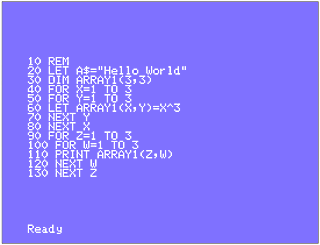|
 |
The Memotech MTX Series |
 |
MTX BASIC Variable Storage

In Memory Format of MTX
BASIC Variables
Courtesy of Bill Brendling
Much of the following
information was derived from the source code of
MTX2BAS produced by
Paul Daniels, supplemented by the authors reading of the MTX
source listing.
List of Variable Names
System variable VARNAM (0xFA7B) points to
the bottom of a list of variable names.
The names in this list are mangled as
follows: Each item in the list starts with the second character
in the name, and continues to the last character. This is then
followed by a byte which encodes both the first letter and the
type of the variable. This byte always has bit 7 set (indicating
the end of the item), bits 5&6 indicate the variable type, and
bits 0-4 give the 5 lsb of the initial letter. The values of
this byte are:
0xE0 –
0xFA A numeric array
0xC0 –
0xDA A numeric value
0xA0 –
0xBA A string array
0x80 –
0x9A A string value
The list is terminated by a 0xFF byte.
The position of a variable name in this
list is called (by the ROM source listing), the UVI of the
variable (the first name has a UVI of one (not zero)).
To find the UVI of a variable, construct a
name string, mangled as above, set DE to the start of this
string and then call to 0x30DC in the BASIC ROM (This is a call
to an unnamed location within the SEARCH (0x30D5) routine.
Returns with the UVI in BC and carry flag set if found,
otherwise with carry flag clear.
List of Variable Values
The list of variable names is followed by
the list of variable values. System variable VALBOT (0xFA7D)
points to the start of the list, and system variable CALCBOT
(0xFA7F) points just beyond the end of the list.
The address of a value item in this list is
given by:
addr = CALBOT –
5 * UVI
This is calculated by routine UVItoSRA
(0x34A0) in the BASIC ROM. Call with UVI in BC, returns with
address in HL.
Each of the items in this list is five
bytes long, and the list is in reverse order of the names list.
The contents of the item varies according
to the variable type identified above.
Numeric Array
Bytes 0-2: 24 bit virtual
address of array data
Bytes 3&4: 16 bit word giving the
number of dimensions.
Numeric Variable
The value of the variable is stored as a
five byte floating point value.
String Array
An array of strings is actually represented
as an array of characters with one extra dimension (the length
of the strings)
Bytes 0-2: 24 bit virtual
address of string array data
Bytes 3&4: 16 bit word giving the
number of dimensions plus 1.
String Variable
Bytes 0-2: 24 bit virtual
address of string data
Bytes 3&4: 16 bit word giving the
length of the string..
Array Data
This includes all strings, which are
treated as arrays of characters.
Virtual Addresses
MTX Basic uses 24 bit virtual addresses to
describe the location of array data (and program code?) in
memory. This means that MTX BASIC is not limited to 48kB. To
translate a virtual address (va) to a physical address the
following algorithm is used:
ram_page = va >>
15
addr = ( va &
0x7FFF) + offset
where offset is 0x4000 for most pages, but
0x8000 for the last page. This means that the last page of
virtual memory can extend into high memory at 0xC000 and above.
Routines VAtoLRA (0x357C) and (LRAtoVA
(0x3593) in the BASIC ROM translate between physical and virtual
addresses.
Numeric Array
The data for a numeric array starts with a
list of the sizes of each dimension, stored as 16 bit words.
This is followed by a list of the floating
point values, five bytes each, stored in the order of last
dimension varying most rapidly (C style, not Fortran style).
String Array
The data for a string array starts with a
list of 16 bit words that give the sizes of each dimension. This
is followed by a 16 bit word giving the length of the strings in
the array (the final dimension of the character array).
This is followed by the characters in the
array, one byte each stored in the order of last dimension (the
position in the string) varying most rapidly.
String variable
The data for a string starts with a 16 bit
word (presumably the length of the string, repeating the value
given in the variable values list) followed by the bytes giving
the text of the string.
|